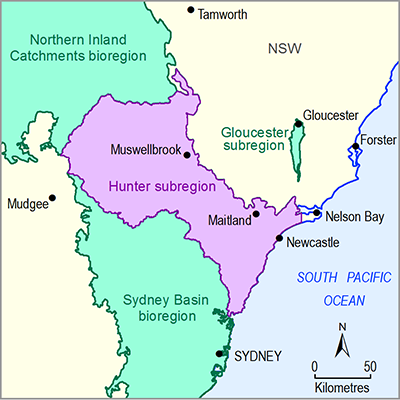- Home
- Assessments
- Bioregional Assessment Program
- Hunter subregion
- 2.7 Receptor impact modelling for the Hunter subregion
- 2.7.2 Prioritising landscape classes for receptor impact modelling
Summary
Landscape classes that intersect the zone of potential hydrological change could potentially be impacted by hydrological changes due to additional coal resource development. Most of the ecological landscape classes in the Hunter subregion intersect the zone; only the ‘Spring’, ‘Barrier river’ and ‘Drowned valley’ landscape classes do not and can be ruled out as very unlikely (less than 5% chance) to be impacted by hydrological changes due to additional coal resource development.
Six quantitative models (receptor impact models) have been developed for five landscape classes in the ‘Riverine’ and ‘Groundwater-dependent ecosystem (GDE)’ landscape groups: perennial streams, intermittent streams, forested wetlands, and wet and dry sclerophyll forests. The quantitative model developed for the ‘Forested wetland’ is specific to riverine forests, and should not be applied to coastal vegetation classes within the ‘Forested wetland’ landscape class.
Qualitative models have been developed for a further five landscape classes, but the experts’ and/or project team’s view was that they are unlikely to be impacted by hydrological changes due to additional coal resource development and quantitative models were not progressed. These qualitative models, which represent ephemeral streams, rainforests, freshwater wetlands, subtidal benthos and intertidal wetlands, have been developed for the ‘Highly intermittent or ephemeral’, ‘Rainforest’, ‘Freshwater wetland’, ‘Seagrass’, and ‘Lakes’, ‘Lagoons’ and ‘Saline wetlands’ landscape classes, respectively.
Four landscape classes that intersect the zone of potential hydrological change do not have qualitative models. They are ‘Heathland’, ‘Grassy woodland’, ‘Semi-arid woodland’ and ‘Creeks’. These landscape classes generally depend on rainfall and/or local groundwater and are considered very unlikely (less than 5% chance) to be impacted by hydrological changes due to additional coal resource development.

Product Finalisation date
- 2.7.1 Methods
- 2.7.2 Prioritising landscape classes for receptor impact modelling
- 2.7.3 'Riverine' landscape group
- 2.7.4 'Groundwater-dependent ecosystem' landscape group
- 2.7.5 'Coastal lakes and estuaries' landscape group
- 2.7.6 Limitations and gaps
- Citation
- Acknowledgements
- Contributors to the Technical Programme
- About this technical product
